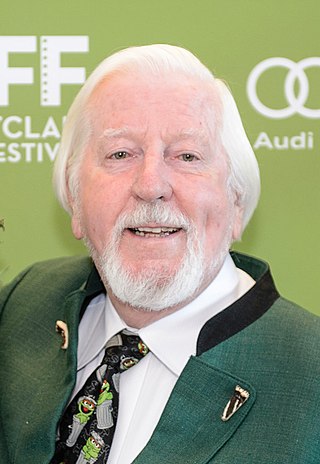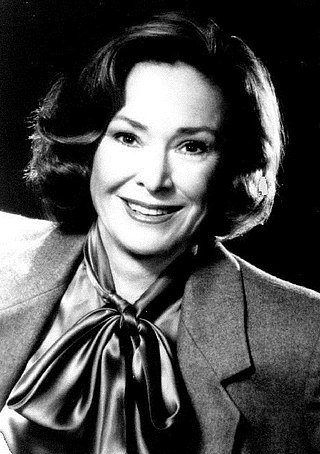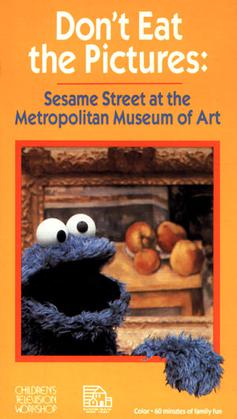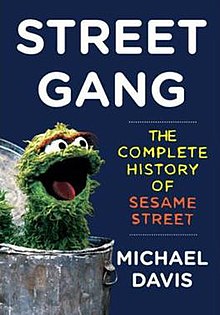
Sesame Street is an American educational children's television series that combines live-action, sketch comedy, animation and puppetry. It is produced by Sesame Workshop and was created by Joan Ganz Cooney and Lloyd Morrisett. It is known for its images communicated through the use of Jim Henson's Muppets, and includes short films, with humor and cultural references. It premiered on November 10, 1969, to positive reviews, some controversy, and high viewership. It has aired on the United States national public television provider PBS since its debut, with its first run moving to premium channel HBO on January 16, 2016, then its sister streaming service HBO Max in 2020. Sesame Street is one of the longest-running shows in the world.

Sesame Workshop (SW), originally known as the Children's Television Workshop (CTW), is an American nonprofit organization that has been responsible for the production of several educational children's programs—including its first and best-known, Sesame Street—that have been televised internationally. Television producer Joan Ganz Cooney and foundation executive Lloyd Morrisett developed the idea to form an organization to produce Sesame Street, a television series which would help children, especially those from low-income families, prepare for school. They spent two years, from 1966 to 1968, researching, developing, and raising money for the new series. Cooney was named as the Workshop's first executive director, which was termed "one of the most important television developments of the decade."

Oscar the Grouch is a Muppet character created by Jim Henson and Jon Stone for the PBS/HBO children's television program Sesame Street. He has a green body, no visible nose, and lives in a trash can. Oscar's favorite thing is trash, as evidenced by the song "I Love Trash", with a running theme being his collection of seemingly useless items. Although the term "Grouch" aptly describes Oscar's misanthropic interaction with the other characters, it also refers to his species. The character was originally performed by Caroll Spinney from the show's first episode until Spinney's retirement in 2018. Eric Jacobson began understudying for the character in 2015, and officially took on the full role after Spinney's retirement in 2018.

Big Bird is a Muppet character designed by Jim Henson and built by Kermit Love for the long-running children's television show Sesame Street. An eight-foot two-inch (249 cm) tall bright yellow anthropomorphic bird, he can roller skate, ice skate, dance, swim, sing, write poetry, draw, and ride a unicycle. Despite this wide array of talents, he is prone to frequent misunderstandings, on one occasion even singing the alphabet as one long word, pondering what it could mean. He would refer to grocer Mr. Hooper as "Mr. Looper", among other mispronunciations. He lives in a large nest behind the 123 Sesame Street brownstone and right next to Oscar the Grouch's trash can. He also has a teddy bear named Radar. In Season 46, Big Bird's large nest is now sitting within a small, furnished maple tree, and is no longer hidden by used construction doors.

Caroll Edwin Spinney was an American puppeteer, cartoonist, author, artist and speaker, most famous for playing Big Bird and Oscar the Grouch on Sesame Street from its inception in 1969 until 2018.

The preschool educational television program Sesame Street was first aired on public television stations on November 10, 1969, and reached its 53rd season in 2022. The history of Sesame Street has reflected changing attitudes to developmental psychology, early childhood education, and cultural diversity. Featuring Jim Henson's Muppets, animation, live shorts, humor and celebrity appearances, it was the first television program of its kind to base its content and production values on laboratory and formative research, and the first to include a curriculum "detailed or stated in terms of measurable outcomes". Initial responses to the show included adulatory reviews, some controversy and high ratings. By its 40th anniversary in 2009, Sesame Street was broadcast in over 120 countries, and 20 independent international versions had been produced. It has won eleven Grammys and over 150 Emmys in its history—more than any other children's show.

Mr. Harold Hooper was one of the first four human characters to appear on the television series Sesame Street. Created by producer and writer Jon Stone, Mr. Hooper is the original proprietor of Hooper's Store, the neighborhood variety store and combination diner/corner store that serves as a place for Muppets and humans to meet and interact. Lee, a character actor and instructor was "perfectly cast" as Mr. Hooper. Mr. Hooper ranked first of all human characters of the show in recognition by young viewers. Mr. Hooper, who has been described as "slightly cranky but good-hearted" and "curmudgeonly", bridges the gap between the older generation and its young audience. Hooper's Store, "an idealized social institution", is an extension of his personality. He had a close relationship with the Muppet Big Bird.

Joan Ganz Cooney is an American television writer and producer. She is one of the founders of Sesame Workshop, the organization famous for the creation of the children's television show Sesame Street, which was also co-created by her. Cooney grew up in Phoenix and earned a Bachelor of Arts in education from the University of Arizona in 1951. After working for the State Department in Washington, D.C., and as a journalist in Phoenix, she worked as a publicist for television and production companies in New York City. In 1961, she became interested in working for educational television, and became a documentary producer for New York's first educational TV station WNET. Many of the programs she produced won local Emmys.

Eric Jacobson is an American puppeteer and actor. He is best known for his involvement with the Muppets, performing Miss Piggy, Fozzie Bear, Animal, and Sam Eagle for The Muppets Studio, as well as Sesame Street characters Bert, Grover, Oscar the Grouch, and Guy Smiley—all roles that he inherited from the characters' original performers, Frank Oz, Caroll Spinney, and Jim Henson.
Sesame Street... 20 Years & Still Counting is a 1989 television special celebrating the 20th Anniversary of Sesame Street. Hosted by Bill Cosby, the special aired on Friday, April 7, 1989, on NBC.

Don't Eat the Pictures: Sesame Street at the Metropolitan Museum of Art is a one-hour Sesame Street special that aired on PBS on November 16, 1983. The title comes from a song in the special, "Don't Eat the Pictures", sung by Cookie Monster. It was available as a video tape by Random House in 1987, and it was re-released on VHS by Sony Wonder in 1996 and on DVD in 2011. The special has everybody reprising their roles from the children's television series, Sesame Street. The story takes on getting locked in at New York City's Metropolitan Museum of Art as they embark on an adventure to find their friend Big Bird, who has gotten lost finding Snuffy. They must stay there until the morning while avoiding a night watchman. The special features the regular human cast of Sesame Street along with several of The Muppets, including Cookie Monster, Telly, Bert & Ernie, The Count, Grover, and Oscar the Grouch. Snuffy also appears, even though his names are revealed to be Mr. Snuffleupagus and Aloysius Snuffleupagus; however, at this point in the show's history, he is still the imaginary friend of Big Bird, never seen by the other characters on Sesame Street.
The Robinson family is a fictional family in the children's television series Sesame Street. The family consists of high school science teacher Gordon and his wife, Susan, a nurse. Later, the family expands to include their adopted son, Miles, as well as Gordon's sister, Olivia, his father, Mr. Robinson, and a brother. As African Americans, the family was created as leads for the show, originally targeted to underprivileged inner city children. Even as human roles were slowly reduced over the years, their characters maintained a constant presence.

Jon Arthur Stone was an American writer, director, and producer who was best known as an original crewmember on the children's television show Sesame Street and is credited with helping to develop characters such as Cookie Monster, Oscar the Grouch and Big Bird. Stone won 18 television Emmy Awards. Many regard him as among the best children's television writers.
A wide variety of characters have appeared on the American children's television series Sesame Street. Many of the characters are Muppets, which are puppets made in Jim Henson's distinctive puppet-creation style. Most of the non-Muppet characters are human characters, but there are many characters that are animated.

Lloyd Newton Morrisett Jr. was an American experimental psychologist with a career in education, communications, and philanthropy. He was one of the founders of the Children's Television Workshop, the organization that created the children's television show Sesame Street, which Morrisett created with Joan Ganz Cooney.

Children and Television: Lessons from Sesame Street (1974) is a non-fiction book written by Gerald S. Lesser, in which he describes the production of Sesame Street, and the formation and pedagogical philosophy of the Children's Television Workshop. Lesser was a professor at Harvard University, studying how social class and ethnicity interacted with school achievement and was one of the first academics in the US who researched how watching television affected children and their development. He was initially skeptical about the potential of using television as a teaching tool, but he was eventually named as the advisory board chairman of the Children's Television Workshop (CTW), the organization created to oversee the production and research of Sesame Street, and was the show's first educational director. Lesser wrote the book early in Sesame Street's history, to evaluate the show's effectiveness, to explain what its writers, researchers, and producers were attempting to do, and to respond to criticism of Sesame Street.

Music has been a part of the children's television show Sesame Street since its debut on PBS in 1969. For the first time, music was used as a teaching tool on a TV program for children; the songs written and performed on the show fulfilled specific purposes and supported its curriculum. The music on Sesame Street consisted of many styles and genres, but was consistent and recognizable so that it could be reproduced. The producers recorded and released dozens of albums of music; many songs became "timeless classics". In order to attract the best composers and lyricists, CTW allowed songwriters to retain the rights to the songs they wrote, which allowed them to earn lucrative profits. Sesame Street Book & Record, recorded in 1970, went gold and won a Grammy. As of November 2019, Sesame Workshop has partnered with Warner Music Group's Arts Music division to reform Sesame Street Records to make the music of Sesame Street fully available.
The children's television program Sesame Street premiered in 1969 to high ratings, positive reviews, and some controversy, which have continued during its history. Even though the show aired on only 67% of American televisions at the time of its premiere, it earned a 3.3 Nielsen rating, or 1.9 million households. By its tenth anniversary in 1979, 9 million American children under the age of six were watching Sesame Street daily. Its ratings declined in the 1990s, due to societal changes. A survey conducted in 1996 found that by the age of three, 95% of all American children had watched it. By its fortieth anniversary in 2009, it was ranked the fifteenth most popular children's show.













